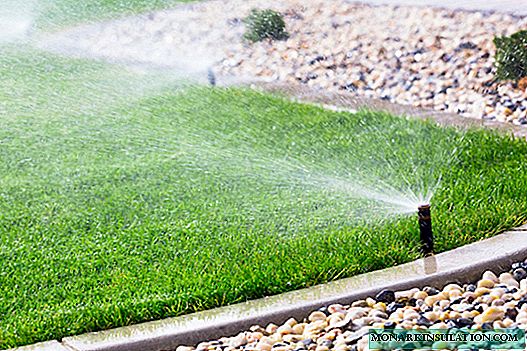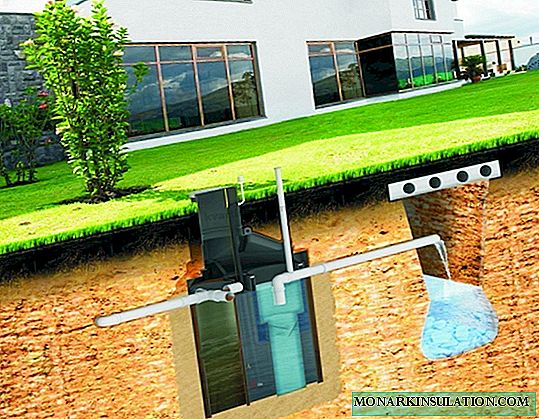
If water is brought into the house at the cottage, then, of course, you need to think through the sewage system. You will not take out sewage in buckets. But since country houses are usually used only periodically, in the spring-summer, or on weekends, the owners are not interested in installing ultra-modern types of sewers, for example, biological treatment plants, etc. They are interested in the simplest options with simple installation and low costs. The main thing is that the sewage system is reliable, excludes the penetration of effluents into fertile land and does not require special maintenance. We will figure out how to install the simplest sewage system in your country house.
General or separate sewerage: which is more profitable?
Before you begin construction work, decide how you intend to remove wastewater from the bathroom, kitchen and toilet - in one place or in different. The type of capacity into which the effluents will flow will depend on this. If approached rationally, the option of separate containers is more beneficial for the owners, because water from the kitchen, washing machine, shower, etc. can be released through a cesspool without a bottom into the ground. They do not pose a danger to the soil, because the bacteria manage to process trapped effluent from washing powders, shampoos, etc.
Another thing is sewage with feces. They can’t be let into the ground, because you will create a lot of problems for yourself: you will violate the ecology of the earth, ruin the soil in the garden, and worst of all, these sewages will calmly fall into the groundwater and with them will return back to the house as drinking water. For drains from the toilet, you must create a sealed cesspool or septic tank. In any case, it is not beneficial for you if all drains from the house will flow into this pit, because the tank will start to fill up quickly, and you will often have to call a sewage machine or pump it out yourself with a special fecal pump and take it out for disposal.
Important! If the main source of drinking water in the country is its own well, then it is forbidden to install any sewage system without a bottom!
Sewerage for drains from the kitchen and washbasin
The easiest option for local sewage is for drains from the kitchen and wash basin. It is usually mounted if the toilet is made on the street, or the owners installed a dry closet.
Since household wastewater is not considered harmful, it is enough to bring them through a pipe system to the street, where a container without a bottom with filter material will be buried. Consider the ways in which this can be done.
Option 1 - from a plastic can
If you live in a country house only in the warm season, it is easiest to mount a sewer made of plastic can and plastic pipes.

From materials you will need an unnecessary old can with a cover of 45-50 liters, ordinary sewer pipes made of plastic with Ø50 mm and accessories for them (a pair of elbows, gaskets, etc.)
Consider how to step by step to make such a sewer in the country:
- On the street, select the place where you will dig the can so that the distance from it to the point of exit of the sewer pipe from the foundation is no more than 4 m.
- Dig a hole a meter deep so that the can fits freely, and dig a ditch half a meter deep from it to the foundation.
- Make sanding at the bottom of the pit with layers of sand and expanded clay.
- Drill at least 1 cm in diameter on the bottom and walls of the can of holes (the larger the better).
- In the place where the neck of the can ends, drill a hole for the entrance where the pipe will be inserted (exactly in diameter!).
- Put the finished can in the pit.
- Lay the pipes around the house so that the sewer starts under the washbasin, with the top of the riser at a height of 40 cm from the floor. This is necessary to create a pipe slope of 4% for normal water flow.
- Fix the riser on the wall behind the washbasin with a clamp.
- When removing pipes through the foundation, it is best to drill a hole below the ground level by about 20 cm. Then the pipes will not freeze in the winter if water stagnates in them.
- Make sure that the pipe at the exit from the house is higher than at the entrance to the can. So you will avoid stagnation of water in the pipes.
- If you can’t cut a hole in the subfield, you can make it above ground level. But it will be necessary to wrap the pipe (from the foundation to the entrance to the can) with insulating material to protect it from frost.
- Check the created sewage system for the quality of the water stack and the absence of leaks. To do this, turn on the water in the house and let it flow for a couple of minutes, and at that time examine all knees and make sure that the water has reached the can.
- If everything is in order, you can fill up the trench with the pipe. First, spray 15 cm of sand, and then fill in ordinary soil. Smooth a surface with a rake.
- The perforated can is filled up to the neck with gravel, expanded clay or river sand.
- Car tires are placed on top of the filter media. The exact number depends on the depth of the pit. They can fit 2-3. Orient yourself so that the last tire peeks out of the soil about halfway.
- Fill the soil between them and the void ground with soil and compact.
- Cover the can, and on the top cover lay a sheet of tin, slate or a wooden shield.
Option 2 - from car tires
In exactly the same way, the sewer is mounted from car tires, only a hole is dug a little deeper (about 2 meters) and instead of a can, they are laid from the bottom to the top of the tire. Sewer pipe crashes at the second level on top of the tire.

The pipe crashes into the second car tire from above without sealing the inlet, because the septic tank itself is also created unsealed
Note! To use such a sewer all year round, you need to deepen about a meter a trench for the external output of pipes and pack them in some kind of insulation.
Sealed cesspool from the finished container
For fecal sewage in the country, they create the most sealed sewerage device, because the health of the inhabitants of this site depends primarily on this. The easiest way to find a large capacity. They are sometimes written off by chemical processing enterprises. However, a barrel from fuels and lubricants, a milk tanker or a machine that says "Live fish" is also suitable. If you cannot find such containers, you can buy a ready-made sewer well made of plastic.

If you did not purchase a ready-made plastic container, but used an old one from fuels and lubricants, be sure to treat it outside with bitumen mastic to improve waterproofing
Advice! It is best to pick up a barrel with a volume of 3 cubic meters, as the sewage machine will be able to pump it out at a time.
Selection of place for capacity
Fecal sewage should not be located near the cottage itself. The smallest distance from the house is 9 meters, and from a well or a well - 30 meters. It is more profitable to install it near the edge of the site, so that it is easier for the transport to pump out without moving around the entire territory of the country.

It is advisable to arrange the sewer hatch so that it can be easily accessed by the sewer machine along the track on the site, or placed immediately near the entrance
Digging a pit
Digging a barrel hole manually is quite difficult, especially if the groundwater is high. Then the water will arrive faster than you dig. Order an excavator for these purposes. The size of the pit should be such that the barrel fits freely, and only the inlet opening of the hatch remains on the surface of the earth. At the same time, a slight bias towards the hatch is necessarily made at the bottom so that solid particles settle on this side. Then the hose of the sewer machine is easier to grab.
Together with the pit, they dig a trench for laying external sewer pipes. Be sure to dig a trench so that there are no bends, because in the places of turns the feces can get stuck and form plugs. If without turns it does not work, then the bending angle should not be more than 45˚.
Capacity setting
They lower the barrel into the pit with the help of a crane, and if it is not there, they call for the help of familiar men and, like barge haulers on the Volga, tighten it with ropes. The hole for the entrance of the sewer pipe can be cut at the top until the barrel is tightened, or after it is installed in the pit.

The tank is not installed directly into the pit, but with a slight slope towards the hatch, so that it is easier to pump out solid particles from the bottom
Note. If you put not a septic tank, but some kind of barrel, then it is necessary to coat it with bituminous mastic or any other compound that is usually used on the undersides of cars.
Pipe laying
From the tank, they begin to lay pipes to the house, maintaining a slope of 4˚, and then perform the internal wiring of the sewer. When the outer pipes are mounted, the trench is filled up. The voids around the tank are filled with soil, ramming it. A reinforced concrete slab is placed on top, which will prevent the barrel from being pushed out of the frozen soil in winter. Around the upper opening of the tank, a concrete blind area is poured and a sewer hatch is installed in it.

The entire cesspool is hidden under the ground, and on the surface there is only a lid of the sewer manhole through which drainage will be conducted
More complicated option - septic tank device
When a local sewer for a summer residence is created, do not be too lazy to make a street toilet with your own hands. If in the summer you have large companies, then it is better to send them out of need exactly there, thereby saving on capacity resources.











